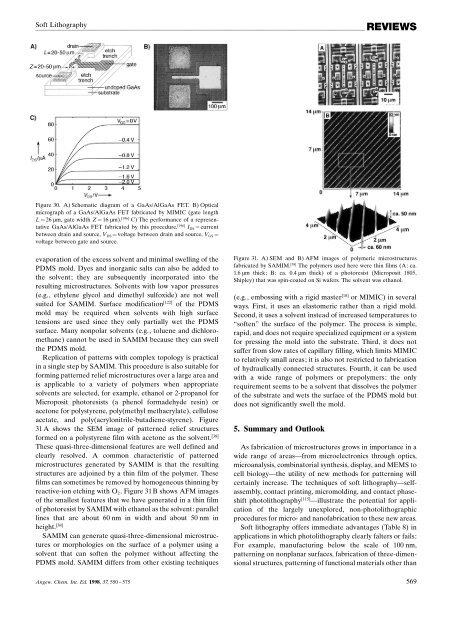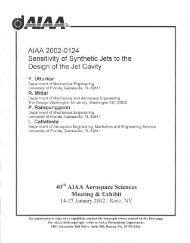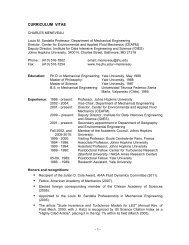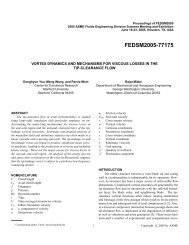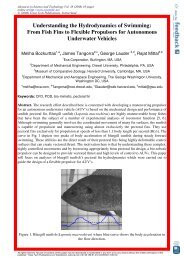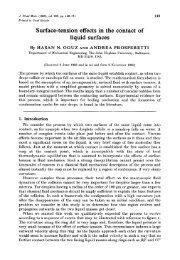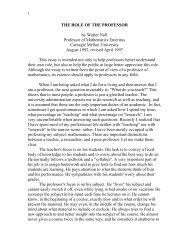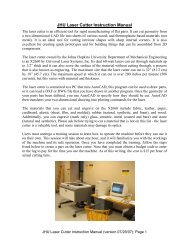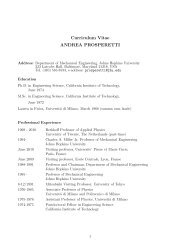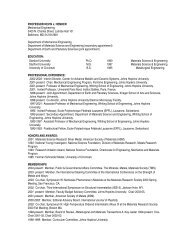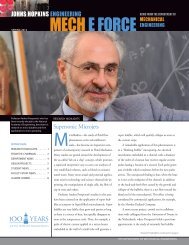Replica molding with a polysiloxane mold provides this ... - EPFL
Replica molding with a polysiloxane mold provides this ... - EPFL
Replica molding with a polysiloxane mold provides this ... - EPFL
Create successful ePaper yourself
Turn your PDF publications into a flip-book with our unique Google optimized e-Paper software.
Soft Lithography<br />
REVIEWS<br />
Figure 30. A) Schematic diagram of a GaAs/AlGaAs FET. B) Optical<br />
micrograph of a GaAs/AlGaAs FET fabricated by MIMIC (gate length<br />
L ˆ 26 mm, gate width Z ˆ 16 mm). [196] C) The performance of a representative<br />
GaAs/AlGaAs FET fabricated by <strong>this</strong> procedure. [196] I DS ˆ current<br />
between drain and source, V DS ˆ voltage between drain and source, V GS ˆ<br />
voltage between gate and source.<br />
evaporation of the excess solvent and minimal swelling of the<br />
PDMS <strong>mold</strong>. Dyes and inorganic salts can also be added to<br />
the solvent; they are subsequently incorporated into the<br />
resulting microstructures. Solvents <strong>with</strong> low vapor pressures<br />
(e.g., ethylene glycol and dimethyl sulfoxide) are not well<br />
suited for SAMIM. Surface modification [122] of the PDMS<br />
<strong>mold</strong> may be required when solvents <strong>with</strong> high surface<br />
tensions are used since they only partially wet the PDMS<br />
surface. Many nonpolar solvents (e.g., toluene and dichloromethane)<br />
cannot be used in SAMIM because they can swell<br />
the PDMS <strong>mold</strong>.<br />
<strong>Replica</strong>tion of patterns <strong>with</strong> complex topology is practical<br />
in a single step by SAMIM. This procedure is also suitable for<br />
forming patterned relief microstructures over a large area and<br />
is applicable to a variety of polymers when appropriate<br />
solvents are selected, for example, ethanol or 2-propanol for<br />
Microposit photoresists (a phenol formadehyde resin) or<br />
acetone for polystyrene, poly(methyl methacrylate), cellulose<br />
acetate, and poly(acrylonitrile-butadiene-styrene). Figure<br />
31 A shows the SEM image of patterned relief structures<br />
formed on a polystyrene film <strong>with</strong> acetone as the solvent. [38]<br />
These quasi-three-dimensional features are well defined and<br />
clearly resolved. A common characteristic of patterned<br />
microstructures generated by SAMIM is that the resulting<br />
structures are adjoined by a thin film of the polymer. These<br />
films can sometimes be removed by homogeneous thinning by<br />
reactive-ion etching <strong>with</strong> O 2 . Figure 31 B shows AFM images<br />
of the smallest features that we have generated in a thin film<br />
of photoresist by SAMIM <strong>with</strong> ethanol as the solvent: parallel<br />
lines that are about 60 nm in width and about 50 nm in<br />
height. [38]<br />
SAMIM can generate quasi-three-dimensional microstructures<br />
or morphologies on the surface of a polymer using a<br />
solvent that can soften the polymer <strong>with</strong>out affecting the<br />
PDMS <strong>mold</strong>. SAMIM differs from other existing techniques<br />
Figure 31. A) SEM and B) AFM images of polymeric microstructures<br />
fabricated by SAMIM. [38] The polymers used here were thin films (A: ca.<br />
1.6 mm thick; B: ca. 0.4 mm thick) of a photoresist (Microposit 1805,<br />
Shipley) that was spin-coated on Si wafers. The solvent was ethanol.<br />
(e.g., embossing <strong>with</strong> a rigid master [18] or MIMIC) in several<br />
ways. First, it uses an elastomeric rather than a rigid <strong>mold</strong>.<br />
Second, it uses a solvent instead of increased temperatures to<br />
ªsoftenº the surface of the polymer. The process is simple,<br />
rapid, and does not require specialized equipment or a system<br />
for pressing the <strong>mold</strong> into the substrate. Third, it does not<br />
suffer from slow rates of capillary filling, which limits MIMIC<br />
to relatively small areas; it is also not restricted to fabrication<br />
of hydraulically connected structures. Fourth, it can be used<br />
<strong>with</strong> a wide range of polymers or prepolymers: the only<br />
requirement seems to be a solvent that dissolves the polymer<br />
of the substrate and wets the surface of the PDMS <strong>mold</strong> but<br />
does not significantly swell the <strong>mold</strong>.<br />
5. Summary and Outlook<br />
As fabrication of microstructures grows in importance in a<br />
wide range of areasÐfrom microelectronics through optics,<br />
microanalysis, combinatorial synthesis, display, and MEMS to<br />
cell biologyÐthe utility of new methods for patterning will<br />
certainly increase. The techniques of soft lithographyÐselfassembly,<br />
contact printing, micro<strong><strong>mold</strong>ing</strong>, and contact phaseshift<br />
photolithography [115] Ðillustrate the potential for application<br />
of the largely unexplored, non-photolithographic<br />
procedures for micro- and nanofabrication to these new areas.<br />
Soft lithography offers immediate advantages (Table 8) in<br />
applications in which photolithography clearly falters or fails:<br />
For example, manufacturing below the scale of 100 nm,<br />
patterning on nonplanar surfaces, fabrication of three-dimensional<br />
structures, patterning of functional materials other than<br />
Angew. Chem. Int. Ed. 1998, 37, 550 ± 575 569


